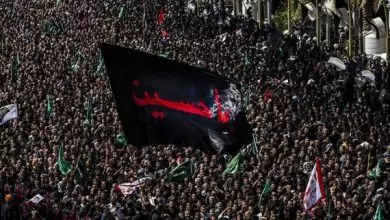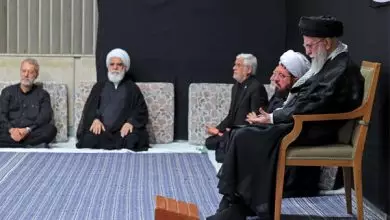Ashura: Emblematic of the Battle Between Righteousness and Falsehood
Ashura represents the timeless battle between truth and falsehood, with the legacy of Imam Hussein (AS) continuing to inspire millions globally. It stands as a potent and lasting emblem of hope and resistance.

The Day of Ashura, observed globally by Muslims, marks the commemoration of Imam Hussein’s martyrdom during the Battle of Karbala, which took place on Muharram 10, 61 AH (October 10, 680).
The event continues to serve as a powerful inspiration for Shia Muslims and others, encouraging them to follow Imam Hussein’s example in striving for independence and liberation.
Imam Hussein, esteemed for his devotion, resisted Yazid’s accession to the caliphate in Damascus, citing Yazid’s unsuitability for the position.
The events of Ashura, although brief, were significant, leaving a lasting impact. Despite attempts to suppress its memory, the lessons of Ashura continue to resonate, as millions commemorate the injustice faced by Imam Hussein.
Shia Muslims commemorate significant rituals during the initial ten days of Muharram, observed this year from July 19 to 28. This period sees hundreds of thousands of devotees journeying to Karbala, Iraq, to pay homage at the shrine of Imam Hussein (AS).
These days are marked to honor the martyrdom of Imam Hussein and seventy-two of his followers, who perished without water in a battle against the forces of Yazid.
Mourning customs encompass donning black attire and decorating streets, mosques, and Husayniyahs with flags of mourning.
Ashura, a significant day of mourning and reflection for Shia Muslims, marks the commemoration of the martyrdom of Imam Hussein in Karbala, Iraq.
Central to the observance are mourning rituals and passion plays that re-enact the historic events.
The Muharram mourning ceremonies hold a central place in Shia culture and are observed worldwide in various forms. Pilgrimages to the shrine of Imam Hussein in Karbala are a common practice among the faithful.
The observance of Ashura holds profound significance beyond Islamic history, symbolizing universal values such as humanity, courage, and integrity.
The observance, embraced by individuals across different faiths, pays homage to these foundational principles. Various communities partake in preparing special meals, distributing them to those in need as a gesture of charity and remembrance. Additionally, some groups participate in blood donation campaigns, echoing the sacrifice made by Imam Hussein.
Mourning is regarded as a profound expression of devotion, serving as a means to resonate with Hussein’s suffering and reinforce one’s dedication to justice.
Ashura stands as a powerful emblem of defiance against tyranny and a rallying cry for moral integrity. It deeply resonates within Shia communities, prompting contemplation on universal ethical values.
In Iran, the observance of Ashura’s night, known as Shaam-e Ghariban or “the night of strangers,” is solemnly commemorated with candle lighting ceremonies at holy sites.
The tragedy has also been noted in nations with substantial Shia populations, such as Iraq, Afghanistan, Azerbaijan, Bahrain, Lebanon, Pakistan, Saudi Arabia, and Syria.
Iranians engage in solemn mourning processions, accompanied by the recitation of elegies. A key aspect of these observances is the distribution of “Nazri,” or votive food, at various kiosks and stalls providing refreshments such as tea and fruit juices. This tradition extends beyond religious boundaries, with non-Muslims also partaking in the offerings from their neighbors.
The tradition has undergone commercialization, as businesses have started to provide Nazri. In Tehran, households prepare an assortment of dishes to distribute among neighbors.
Ta’zieh performances, recognized on UNESCO’s List of the Intangible Cultural Heritage of Humanity, portray religious, historical, and mythological narratives through the mediums of poetry, music, song, and movement.
These theatrical renditions illustrate the events of Ashura, incorporating elements of Iranian musical traditions that trace back to the 9th century. Their popularity surged during the Safavid and Qajar periods.
Renowned miniaturist Mahmud Farshchian crafted “The Evening of Ashura” to both portray a profound tragedy in Muslim history and to demonstrate art’s ability to convey significant historical events.
The artwork vividly illustrates the desolate household of Imam Hussein (AS), engulfed in mourning as his horse returns alone from the battlefield. The Persian miniature painting captures their profound sorrow for their cherished figure with striking authenticity.
Karbala epitomizes the clash between truth and falsehood, justice and prejudice, as well as courage and materialism.
The Muharram ceremonies symbolize the perpetual battle between truth and falsehood, representing the resistance against injustice, tyranny, and oppression. The Day of Ashura stands as a powerful testament to the sacrifices made for principles and highlights the steadfast dedication to justice, even when faced with daunting challenges.
This exemplifies the lasting influence of faith and the unwavering strength of the human spirit.
The narrative of Imam Hussein (AS) transcends historical confines, emerging as a vibrant story that still deeply connects with individuals across diverse backgrounds, all of whom aspire for a world devoid of oppression and filled with justice.
The rituals and traditions observed during Ashura transcend mere acts of mourning; they are deeply meaningful expressions of solidarity with Imam Hussein (AS) and his followers.
They serve as an urgent appeal, encouraging individuals to confront injustice and work towards a more just and compassionate society.
The somber black attire, coupled with mourning flags, elegies, and the practice of Nazri, contribute to a shared experience of grief and remembrance. This collective observance not only strengthens communal ties but also underscores the values of empathy and compassion.
The annual pilgrimage to Karbala attracts hundreds of thousands of devotees who embark on a spiritual journey to connect with the legacy of Imam Hussein (AS). Pilgrims seek to draw inspiration from his steadfast faith and enduring spirit.
The shrine of Imam Hussein (AS) stands as a beacon of hope and a powerful symbol of resistance against oppression, attracting pilgrims from around the world.
The city of Karbala exudes an air of deep devotion and respect during Muharram, creating a transformative spiritual environment that is both profound and palpable.
The tradition of Nazri, also known as votive food, stands as a significant embodiment of generosity and compassion. This practice goes beyond religious divides, promoting a sense of community and shared humanity.
Providing food and beverages to mourners and neighbors serves as a concrete expression of compassion, underscoring the significance of supporting those in need.
The modernization of Nazri, aligning with contemporary trends, simultaneously highlights the lasting importance of this tradition.
Ta’zieh performances represent a distinctive and enthralling artistic expression that vividly portrays the narrative of Ashura.
These dramas, employing elements such as poetry, music, song, and movement, powerfully portray the events of Karbala, resonating with audiences both emotionally and intellectually.
UNESCO’s acknowledgment of Ta’zieh as an Intangible Cultural Heritage of Humanity underscores its importance as a cultural gem and its lasting relevance in today’s society.
At its core, Ashura is a significant and intricate observance that reaches beyond temporal and spatial boundaries.
The situation underscores the timeless battle between opposing forces: good versus evil, truth against falsehood, and justice over injustice. It serves as a rallying cry, encouraging individuals to champion what is right, despite challenges, and to aspire towards a world governed by principles of compassion, empathy, and justice.
The legacy of Imam Hussein (AS) continues to resonate with millions globally, with Ashura standing as a profound and enduring emblem of hope and resilience.






